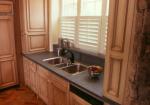Search engine visitors - click here to access entire "$ensible Home" web site
Click here to see a descriptive illustration of several types of solid, high-mass kitchen countertops.
Dear Jim: We are doing a complete remodeling of our kitchen. We know we want the most efficient appliances. What other factors should we consider to make the kitchen as efficient and comfortable as possible? - Ronald B.

A: Major appliances are the primary energy consumers in most kitchens and it makes sense to pay extra for the most efficient ones. A good-quality, quiet range vent hood is another important appliance. If you install a cheap noisy one, you won't run it often enough.
One often forgotten item in a kitchen, which can impact comfort and efficiency, is the countertop. Other than the flooring, the countertop accounts for more area than any other item. It also impacts the kitchen decor.
What typically causes discomfort in a kitchen is temperature variations in the room air when cooking. During winter, cooking warms the room, but the heat is lost outdoors when the range hood runs. During summer, the kitchen overheats, so you often end up setting the air conditioner thermostat lower.
Many of the solid surface countertop materials, which are decorative, are called high-mass materials: tinted concrete, granite, slate, composite quartz, and tile. These high-mass materials absorb excess kitchen heat, moderate temperature swings and rerelease the heat slowly. These countertops are particularly attractive with an undermount stainless steel sink.
Although it may sound "industrial", tinted concrete is very attractive and a popular kitchen countertop material. It has high thermal mass and is durable. It is usually available in precast form or can be custom made for your specific countertop shape. Troweled or veined surface finishes are most common.
If you are a handy do-it-yourselfer, kits are available to pour your own tinted concrete countertop. The kits included the special cement mix, liquid colorant, various-shaped edge forms, surface coat material for a veined finish, and food-grade natural beeswax to seal the surface.
Granite is a durable material and has just slightly less mass than concrete. It has a very hard surface and offers a large range of patterns and colors from pinks through browns and blacks. It is an excellent surface for preparing foods, but like most natural stones, it is porous and must be sealed periodically.
Composite materials, usually 93 percent quartz mixed with resins, are almost as heavy as natural stone and have uniform properties throughout. These do not require sealants like natural stone and are resistant to mold and mildew.
Thick slate has the highest thermal mass and is practically maintenance-free. Ceramic tile is another low-maintenance material. Hard rock maple and heavy red oak countertops are attractive and will add some thermal mass.
Instant Download Update Bulletin No. 737 - buyer's guide of 14 attractive, high-mass countertop and sink manufacturers listing material descriptions (concrete, granite, quartz composite, slate, ceramic tile, heavy wood, colors, features, and a material/pricing selector guide listing weight, repairability, features and drawbacks.
Dear Jim: I am deciding whether to exhaust my bathroom vent fan through the roof or the soffit. Putting it in the soffit is much easier, but is there a problem of the moisture being drawn in other soffit vents? - Maurie N.
A: There is a possibility that some of the moisture-laden air from the bath vent outlet in the soffit may be drawn into another vent, but making a penetration in the roof may result in leaks.
Since the prevailing wind is typically from the west, if you install the outlet in the soffit, mount a small air deflector on the east side of the vent. This will block the direct air path from the outlet into the adjacent soffit vent.